Beach Tennis and Pickleball Converge!
While Pickleball is the fastest growing sport in America, Beach Tennis is trending upward internationally, especially in beach cities throughout Italy, Spain and Brazil. Now a new game called Sandy Pickle is making its way onto the scene, a hybrid blend of these two popular sports. Below is more information about beach tennis, pickleball, and finally the introduction of Sandy Pickle.
It is widely believed that beach tennis was invented in the early 1970s when some tennis players on vacation in Italy took their rackets to the beach volleyball courts and volleyed tennis balls back and forth. It must have drawn enough attention that somebody eventually created rules and played it for the first time in an organized fashion in Spain in 1976.
From what was originally just “something to do” rather than an intended invention of a new sport, beach tennis began spreading throughout Europe. Today it is estimated that there are over 250,000 beach tennis players in Italy where the sport is now second only to soccer in popularity. As the game began growing beyond Europe, it naturally found its way to Brazil and its world famous Rio de Janeiro beaches.
Pickleball was invented just 5 years prior to beach tennis, but it wasn’t until around 2010 that the popularity of both sports really caught fire. Prior to 2010, pickleball was recognized mostly as a sport for retirees, and while popular, it was mostly a recreational activity played in retirement communities. Today, the best players in the world include former tennis professionals, and the competitive nature of pickleball has it on the fast track to becoming an Olympic sport.
In 2020, a couple friends decided to try playing pickleball on sand and grass. Because the ball doesn’t bounce on soft surfaces, the “new” game was an all-volley version of pickleball. As the game matured and became what is now known as Sandy Pickle, people around the world noticed and began comparing it to beach tennis. Today, Sandy Pickle is making its way onto beach tennis courts in Italy, Spain, Brazil and beach cities around the world.
For more information* about Sandy Pickle, please see sandypickle.com.
*International distributors, please contact support@sandypickle.com.
What Changes Were Made As “Grass Pickleball” Became Sandy Pickle?
Now you can play pickleball on the grass, at the beach, or in your own yard with Sandy Pickle! Read below for a summary of the rules.
1. Smaller Court Dimensions:
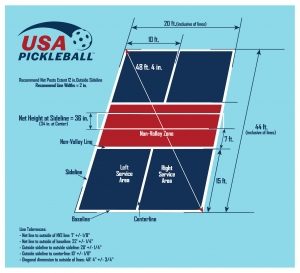
We adjusted the court size to accommodate for the fact that players can’t move as fast on grass or sand, and every shot is a volley since the ball doesn’t bounce.
In comparison to pickleball, Sandy Pickle’s boundaries are slightly smaller, and the center line has been eliminated.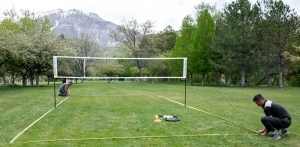 The singles* court width is 13′ 6″ (4.1 meters), and doubles is 16′ 8″ (5.1 meters), with baselines at 16′ for singles and 18′ for doubles.
The singles* court width is 13′ 6″ (4.1 meters), and doubles is 16′ 8″ (5.1 meters), with baselines at 16′ for singles and 18′ for doubles.
*SandyPickle’s proprietary net design allows for easy width adjustment between singles & doubles.
2. Adjustable Net Height
For the same reasons as in #1, the net needed to be raised from the standard 36 inch pickleball height.
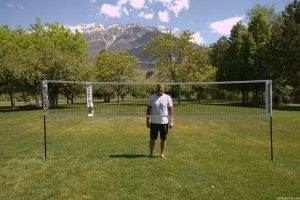
For recreational play, the net should be set to the approximate height of the tallest player on the court. For tournament play, the default height is 6’ but may be modified to accommodate for optional height and/or skill divisions.
3. No-Spike Zone
The area within 5’ of the net on each side is called the “No Spike Zone” (similar to the “Kitchen” in pickleball).
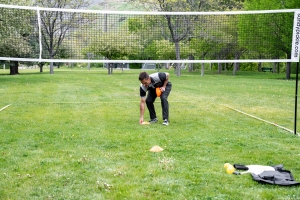 On each serve, the return must be made from behind the no-spike zone; At all other times, the only restriction to playing inside this area is that no part of the paddle may be above the top of the net when making contact with the ball (i.e. no spiking).
On each serve, the return must be made from behind the no-spike zone; At all other times, the only restriction to playing inside this area is that no part of the paddle may be above the top of the net when making contact with the ball (i.e. no spiking).
4. No Bounces
Balls don’t bounce well on sand or grass, therefore each shot must be hit before the ball touches the ground.
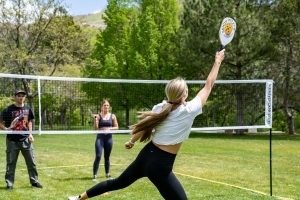 Sometimes described as a hybrid of pickleball and badminton, Sandy Pickle also borrows the “bump” from volleyball. The addition of the 1-pass rule in doubles play allows a player to bump, or pass to their teammate who then must hit the ball over the net on the subsequent shot.
Sometimes described as a hybrid of pickleball and badminton, Sandy Pickle also borrows the “bump” from volleyball. The addition of the 1-pass rule in doubles play allows a player to bump, or pass to their teammate who then must hit the ball over the net on the subsequent shot.
Longer, volley-only rallies make for a fast-paced game that is almost as fun to watch as it is to play!
5. Serving
Serves are made from behind the baseline with no limitations as to which side of the court they are hit from or to. Also unlike pickleball, players may serve overhead.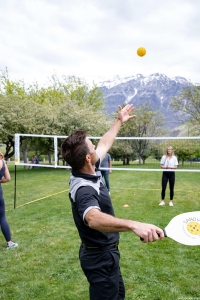
A serve is “out” if it lands within the no-spike zone or outside court boundaries. If the ball hits the net but lands within the boundaries, it is a “let” and the serve is repeated. The player serving continues until they lose a point, after which their opponent takes over (unlike pickleball, in doubles play the serve alternates sides at the end of each serving opportunity).
6. Scoring
Like pickleball, games are played to 11 points and must be won by 2 (or more). A point is earned when the player or team serving wins the point. If the player or team RECEIVING the serve wins the point, they take over the serve.
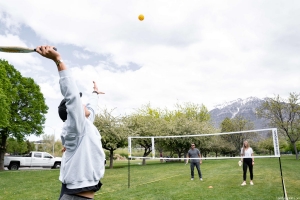 Scoring Note: When a team is winning 7-6, for example, the player serving would call out “7-6” rather than “7-6-1”.
Scoring Note: When a team is winning 7-6, for example, the player serving would call out “7-6” rather than “7-6-1”.


